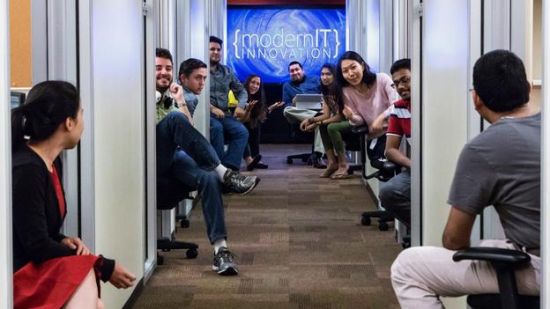微软公司抵制开放式办公浪潮(双语)
As more employers adopt an open design plan with private offices, Pankaj Arora and his young information technology innovation team at Microsoft are bucking the trend。
越来越多的雇主私人办公室中采取了开放式设计, 但是微软公司的阿罗拉及其年轻的技术创新团队则反其道而行。
 微软公司抵制开放式办公浪潮
微软公司抵制开放式办公浪潮They discussed an open floor plan. When they need to collaborate, they simply open their doors and roll their desk chairs out into the corridor, which they have dubbed the “hallway of knowledge。”
他们讨论了开放房屋计划,需要合作时就打开房门,将写字椅拉倒走廊,并将此走廊称之为“知识走廊”。
Like Arora and his team, many workers today crave a haven for privacy and concentration. Collaboration is critical, of course, especially at technology companies, but too much togetherness can sap productivity and creativity. Many people are growing frustrated with the din and distractions of the modern office. Call it the backlash against the open office plan。
现今,很多员工都与阿罗啦及其团队一样,渴望拥有保护隐私且有助于集中精力的工作环境。诚然,合作非常重要,在科技公司中合作尤其重要,但是过于集中有损生产力和创造力。很多员工越来越对现代办公室的喧嚣感到沮丧。这是对开放式办公室的强烈抵制。
More than two-thirds of US employees are unhappy with noise levels at work, and 53% say other people disturb them when they try to focus, according to a 2013 survey by Gensler, a global design firm。
据设计公司美国晋思2013年的一项调查表明,美国超过三分之二的员工都对工作时的噪音水平感到不满。53%的员工表示他们试图集中精力时总会有人来打扰他们。
One solution to the noise problem is to compromise by designing workspaces that balance the need for interaction with colleagues and quiet time to focus. To that end, some employers have begun building more small rooms into their design plans.These “huddle rooms”can provide solitude when workers need a refuge from ringing phones and chatty colleagues. They tend to be small and usually accommodate one person or a small group. They might include a work table and chair, or simply a standing desk。
解决噪音问题的一个方法就是,设计工作场所时,在同事之间的交流需要以及员工需要集中精力之间寻求一种平衡。为了实现这个目的,很多雇主都开始在自己的设计计划中加入了更多的小房间。当员工需要远离此起彼伏的铃声或者喋喋不休的同事时,这些“小房间”恰能为其提供一份宁静。此类房间通常很小,仅容一人或一个小团队。房间里一般会有一张办公桌及一把椅子,或者仅有一张站式桌子。
At Microsoft, some employees are stationed in “neighbourhoods” with open layouts and various rooms. The neighbourhoods are located away from high-traffic corridors to minimise visual distractions.Workplace design experts recommend that some private rooms be reservation only, with others available on a first come-first served basis。
微软公司一些员工的办公区位于“街区”拥有开放式布局和各式房间。办公区远离人流不断的走廊,以减少视觉扰乱。工作场所设计专家建议,一些房间只能预定,而其他房间则采取先到选得的原则。
Although a mix of open and private areas may sound like an ideal solution to the noise problem, some companies fail to provide enough quiet zones to meet everyone’s needs。
融合开放区域和私人区域可能是解决噪音问题的最佳方法,但是很多公司都未能提供足够的安静空间,满足所有员工的要求。
Despite growing concerns about privacy and distractions, some employers are taking the open office concept even further with so-called “free-address” workspaces where employees don’t even have assigned seats. Such offices might seem like a recipe for even more chaos, but at least an employee won’t get stuck sitting next to the office loudmouth day in and day out。
尽管有关隐私和注意力分散的问题越来越严重,一些雇主仍然倡导开放式办公室,并将其称之为“无固定座位”的工作场所。这类办公室可能会导致更多的混乱,但是至少有一名员工不用每天都面对高声讲话的人。
However, the very social millennial generation doesn’t seem to mind the hubbub in open-plan workspaces. Millennials, born in the 1980s and 1990s, see the same drawbacks to open layouts as older people. But they strongly believe that the opportunities to socialise, work in teams or get help from colleagues outweigh the negatives. No matter what other millennials say, however, Microsoft’s Arora and his young IT team are clinging to their private offices。
但是,善于社交的千禧一代似乎并不介意开放式办公室中的喧嚣。出生于二十世纪八九十年代的千禧一代也同老人一样,深知开放式办公室的缺点所在。但是他们坚持认为与缺点相比。开放式办公室所提供的社交机会、团队协作以及其他同事的帮助更为重要。但是不管千禧一代怎么说,微软公司的阿罗拉及其年轻的信息技术团队还是坚持选择了他们的私人办公室。
- 双语:关于微软Surface3你必须知道的6件事2015-04-03 10:26
- 代号斯巴达:微软发布新浏览器取代IE(双语)2015-04-02 11:01
- 双语课堂:盗版用户也能免费升级微软系统2015-03-20 10:42
- 双语:盗版用户也能免费升级微软产品(图)2015-03-20 10:24
- 5岁娃发现微软游戏漏洞成安全研究人员2014-12-16 14:21

